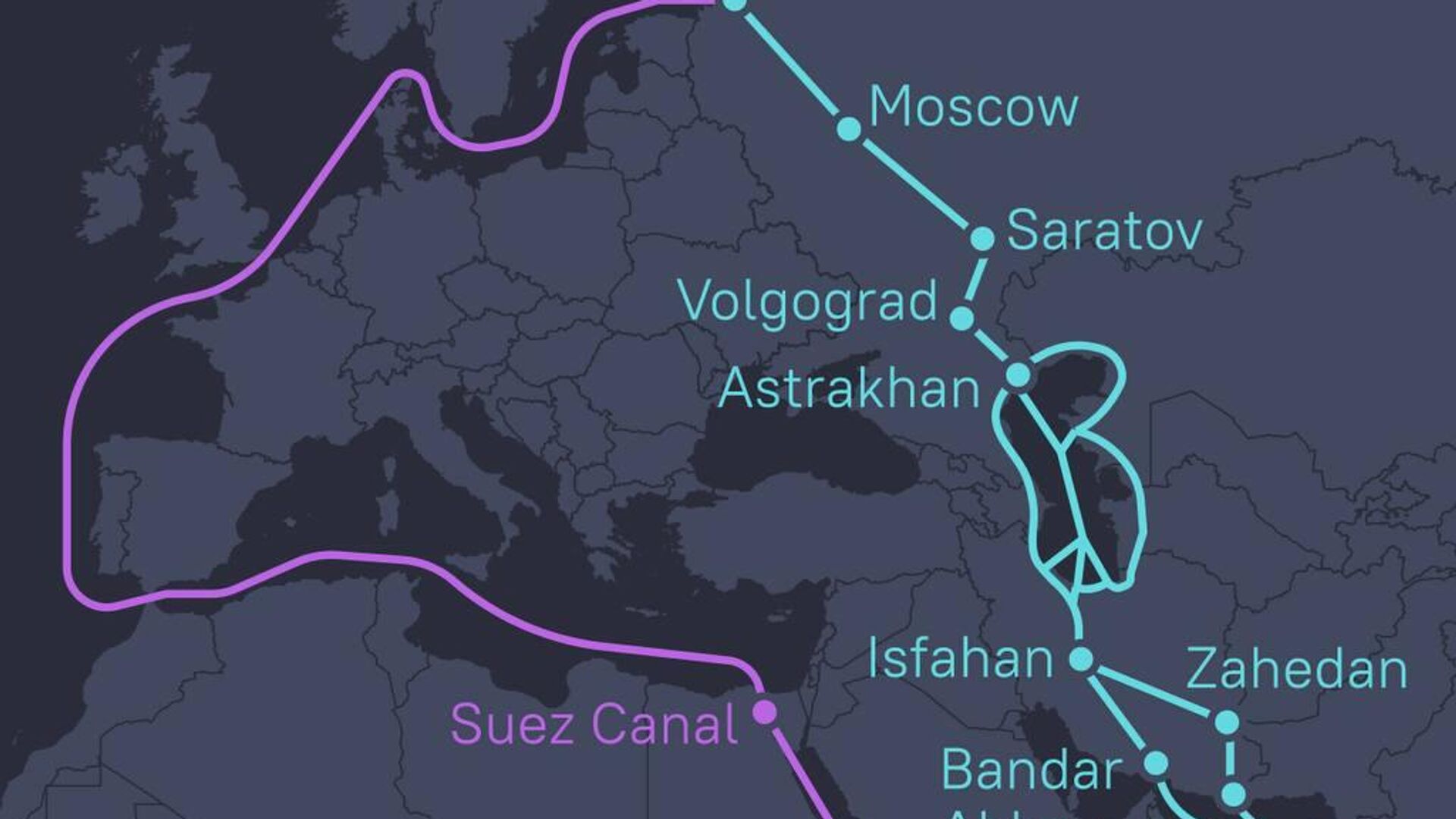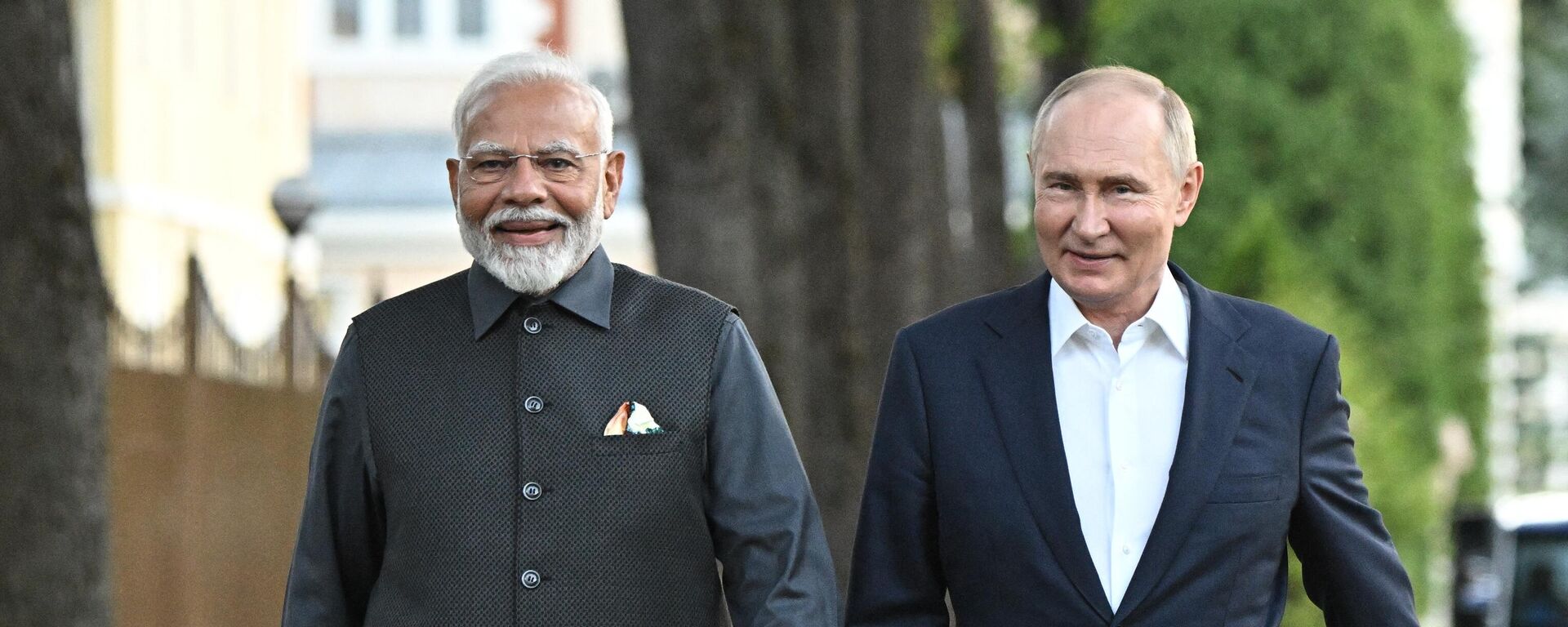https://sputniknews.in/20240830/rasht-astara-railway-crucial-to-enhancing-indias-trade-volume-8086858.html
Rasht-Astara Railway: Crucial to Enhancing India's Trade Volume
Rasht-Astara Railway: Crucial to Enhancing India's Trade Volume
Sputnik India
Russian President Vladimir Putin highlighted the importance of infrastructure initiatives such as the Rasht-Astara railway and the International North-South... 30.08.2024, Sputnik India
2024-08-30T20:46+0530
2024-08-30T20:46+0530
2024-09-04T15:30+0530
sputnik opinion
rohit sharma
vladimir putin
rajnath singh
india
russia
iran
suez canal
moscow
chabahar port
https://cdn1.img.sputniknews.in/img/07e8/01/11/6239483_0:353:1024:929_1920x0_80_0_0_d8cd2dd6bd019b4282bc82b71405b0eb.jpg
The Rasht-Astara railway is part of the North-South Economic Corridor and looks to enhance regional connectivity, streamline transport from Kandla to Chabahar, and support efficient oil and gas imports, according to experts."The 162 km Rasht-Astara railway is the main missing link in the INSTC, an initiative that was initially signed between India, Russia and Iran in 2000, but was later expanded to include more countries from Eurasia," Dr Raj Kumar Sharma, a senior research fellow at NatStrat, told Sputnik India.He highlighted that Russia's interest in building the railway is crucial for linking the country and Iran to India, South Asia’s primary market, especially as the nations seek to boost trade with states not supporting Western sanctions."South Asia itself has issues of regional economic integration but the INSTC connects India directly with Russia and Iran," Sharma affirmed.Consequently, according to Sharma, India is exploring alternative routes to its Eurasian markets, with the INSTC being a promising option."Some key challenges include infrastructural, administrative, tariff and financial barriers, lack of coordination in customs and the red tape related to border crossings," he added.However, Sharma emphasised that while despite the challenges, the INSTC will boost development in landlocked Eurasian countries and has the potential to become a significant energy corridor in the region.Meanwhile, a fully operational INSTC combined with the Free Trade Agreement between India and the Eurasian Economic Union, according to Sharma, will boost India's trade with various countries beyond $100 billion, with India-Russia trade being a major beneficiary, thereby refocusing India's strategic ties in Eurasia."The corridor could also potentially connect to Southern and Eastern Europe, but ongoing geopolitical issues, such as sanctions on Russia and Iran and instability in Afghanistan, raise concerns about its immediate viability," Ambassador Gurjit Singh, a former Indian diplomat, told Sputnik India.In the meantime, the INSTC, a vital initiative long championed by India, is key to linking Chabahar Port with Central Asia, Russia, and eventually Europe, Qamar Agha, a foreign affairs expert pointed out that in a conversation with Sputnik India,The project faced delays due to the Ukraine war but "remains a priority for India, Iran, Azerbaijan, and other regional stakeholders," Agha reckoned.He noted that once operational, the corridor would improve connectivity between Central Asia, the Caucasus, Russia, Turkiye, and other countries, enhancing regional integration.The expert proposed that the corridor will also boost trade between South and Central Asia by facilitating the transport of oil, gas, and other goods, and will connect India with various regions through railway and pipeline networks.Additionally, the pundit emphasized the project's importance in accessing the region’s rich oil and gas resources, with the Rasht-Astara railway being vital for establishing the necessary connectivity for India's imports.“India's commitment to globalization ensures it will keep investing in the North-South Corridor and seek partnerships to expand it further," Singh concluded.Earlier, following the recent trip of Russian President Vladimir Putin to Azerbaijan, Presidential Aide Igor Levitin held discussions with Iran's Ambassador Kazem Jalali in Moscow, highlighting the importance of advancing the Rasht-Astara railway segment, which is a vital part of the INSTC's western branch.In turn, Jalali emphasised that in 2023, the eastern segment of the INSTC saw its first transportation of around 650,000 metric tons of goods.Additionally, the volume of cargo moved through the Caspian Sea route grew to 10 million metric tons in 2023, a significant rise from the 6 million metric tons in 2022.
https://sputniknews.in/20240807/counterbalance-strong-pitch-for-russias-engagement-in-indo-pacific-7976592.html
india
russia
iran
suez canal
moscow
chabahar port
afghanistan
europe
greater eurasia
Sputnik India
feedback.hindi@sputniknews.com
+74956456601
MIA „Rossiya Segodnya“
2024
Swapna Nair
https://cdn1.img.sputniknews.in/img/07e7/09/12/4320104_0:0:681:681_100x100_80_0_0_ca8a7d4d582609272840ffdd1cde7278.jpg
Swapna Nair
https://cdn1.img.sputniknews.in/img/07e7/09/12/4320104_0:0:681:681_100x100_80_0_0_ca8a7d4d582609272840ffdd1cde7278.jpg
News
en_IN
Sputnik India
feedback.hindi@sputniknews.com
+74956456601
MIA „Rossiya Segodnya“
Sputnik India
feedback.hindi@sputniknews.com
+74956456601
MIA „Rossiya Segodnya“
Swapna Nair
https://cdn1.img.sputniknews.in/img/07e7/09/12/4320104_0:0:681:681_100x100_80_0_0_ca8a7d4d582609272840ffdd1cde7278.jpg
azerbaijan, russian president vladimir putin, rasht-astara railway, international north-south transport corridor (instc), russian presidential, igor levitin, putin, rasht-astara railway, instc's western branch, moscow, iran's ambassador kazem jalali, iranian ambassador jalali, instc, cargo, caspian sea route, rasht-astara railway, india, russia, iran, eurasia, dr. raj kumar sharma, senior research fellow, natstrat, russia's, railway, iran to india, south asia’s primary market, western sanctions, south asia, instc, india, russia, iran, instc, cost-effective route, suez canal, houthi attacks, red sea, indian trade, eurasian markets, instc, infrastructural, administrative, tariff and financial barriers, lack of coordination, border crossings, instc, landlocked eurasian countries, india-eurasia trade, instc, free trade agreement, india, eurasian economic union, india-russia trade, india's strategic ties, eurasia, southern and eastern europe, russia and iran, afghanistan, ambassador gurjit singh, former indian diplomat, russia, arctic route, foreign affairs expert, international north-south transport corridor, chabahar port, central asia, russia, europe, india, iran, azerbaijan, central asia, the caucasus, russia, turkey, south and central asia, rasht-astara railway project, international north-south transport corridor, chabahar port, kandla port, gujarat to chabahar, railways and roads, india's imports, globalization, north-south corridor
azerbaijan, russian president vladimir putin, rasht-astara railway, international north-south transport corridor (instc), russian presidential, igor levitin, putin, rasht-astara railway, instc's western branch, moscow, iran's ambassador kazem jalali, iranian ambassador jalali, instc, cargo, caspian sea route, rasht-astara railway, india, russia, iran, eurasia, dr. raj kumar sharma, senior research fellow, natstrat, russia's, railway, iran to india, south asia’s primary market, western sanctions, south asia, instc, india, russia, iran, instc, cost-effective route, suez canal, houthi attacks, red sea, indian trade, eurasian markets, instc, infrastructural, administrative, tariff and financial barriers, lack of coordination, border crossings, instc, landlocked eurasian countries, india-eurasia trade, instc, free trade agreement, india, eurasian economic union, india-russia trade, india's strategic ties, eurasia, southern and eastern europe, russia and iran, afghanistan, ambassador gurjit singh, former indian diplomat, russia, arctic route, foreign affairs expert, international north-south transport corridor, chabahar port, central asia, russia, europe, india, iran, azerbaijan, central asia, the caucasus, russia, turkey, south and central asia, rasht-astara railway project, international north-south transport corridor, chabahar port, kandla port, gujarat to chabahar, railways and roads, india's imports, globalization, north-south corridor
The Rasht-Astara railway is part of the North-South Economic Corridor and looks to enhance regional connectivity, streamline transport from Kandla to Chabahar, and support efficient oil and gas imports, according to experts.
"The 162 km Rasht-Astara railway is the main missing link in the INSTC, an initiative that was initially signed between
India, Russia and Iran in 2000, but was later expanded to include more countries from Eurasia,"
Dr Raj Kumar Sharma, a senior research fellow at NatStrat, told
Sputnik India.
He highlighted that Russia's interest in building the railway is crucial for linking the country and Iran to India, South Asia’s primary market, especially as the nations seek to boost trade with states not supporting Western sanctions.
"South Asia itself has issues of regional economic integration but the INSTC connects India directly with Russia and Iran," Sharma affirmed.
The expert noted that the INSTC offers a shorter and more cost-effective trade route compared to the Suez Canal, which India had used but had to reconsider due to Houthi attacks in the Red Sea and the canal's six-day closure in March 2021 that disrupted the trade.
Consequently, according to Sharma, India is exploring alternative routes to its Eurasian markets, with the INSTC being a promising option.
"Some key challenges include infrastructural, administrative, tariff and financial barriers, lack of coordination in customs and the red tape related to border crossings," he added.
However, Sharma emphasised that while despite the challenges, the INSTC will boost development in
landlocked Eurasian countries and has the potential to become a significant energy corridor in the region.
Meanwhile, a fully operational INSTC combined with the Free Trade Agreement between India and the Eurasian Economic Union, according to Sharma, will boost India's trade with various countries beyond $100 billion, with India-Russia trade being a major beneficiary, thereby refocusing India's strategic ties in Eurasia.
"The corridor could also potentially connect to Southern and Eastern Europe, but ongoing geopolitical issues, such as sanctions on Russia and Iran and instability in Afghanistan, raise concerns about its immediate viability," Ambassador Gurjit Singh, a former Indian diplomat, told Sputnik India.
While there are issues, India remains committed to building these connections, viewing them as long-term projects and continuing discussions with Russia about the Arctic route, Singh illustrated.
In the meantime, the INSTC, a vital initiative long championed by India, is key to linking Chabahar Port with Central Asia, Russia, and eventually Europe, Qamar Agha, a foreign affairs expert pointed out that in a conversation with Sputnik India,
The project faced delays due to the Ukraine war but "remains a priority for India, Iran, Azerbaijan, and other regional stakeholders," Agha reckoned.
He noted that once operational, the corridor would improve connectivity between Central Asia, the Caucasus, Russia, Turkiye, and other countries,
enhancing regional integration.The expert proposed that the corridor will also boost trade between South and Central Asia by facilitating the transport of oil, gas, and other goods, and will connect India with various regions through railway and pipeline networks.
Additionally, the pundit emphasized the project's importance in accessing the region’s rich oil and gas resources, with the Rasht-Astara railway being vital for establishing the necessary
connectivity for India's imports.
He explained that this initiative will link various regional countries and integrate with Chabahar Port, enabling goods to travel from Kandla Port in Gujarat to Chabahar in four to five days, with distribution to other countries via a streamlined network of railways and roads, thereby significantly reducing costs and transit times.
“India's commitment to globalization ensures it will keep investing in the North-South Corridor and seek partnerships to expand it further," Singh concluded.
Earlier, following the recent trip of Russian President Vladimir Putin to Azerbaijan, Presidential Aide Igor Levitin held discussions with Iran's Ambassador Kazem Jalali in Moscow, highlighting the importance of advancing the Rasht-Astara railway segment, which is a vital part of the INSTC's western branch.
Likewise, Levitin revealed during a meeting that the project is designed to transport 15 million metric tons of goods annually.
In turn, Jalali emphasised that in 2023, the eastern segment of the INSTC saw its first transportation of around 650,000 metric tons of goods.
Additionally, the volume of cargo moved through the Caspian Sea route grew to 10 million metric tons in 2023, a significant rise from the 6 million metric tons in 2022.



